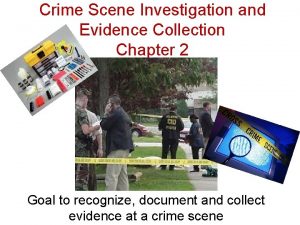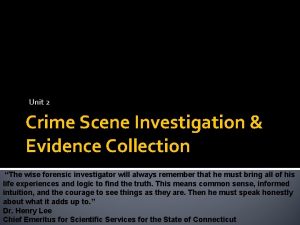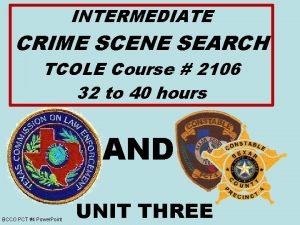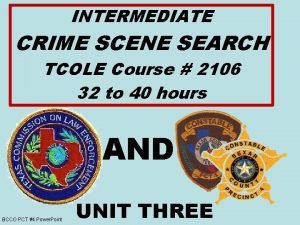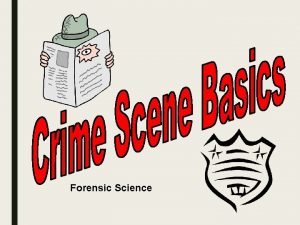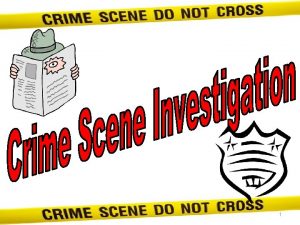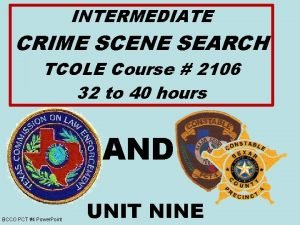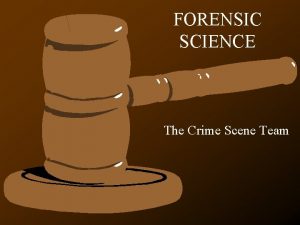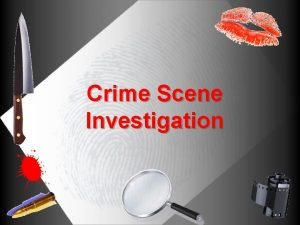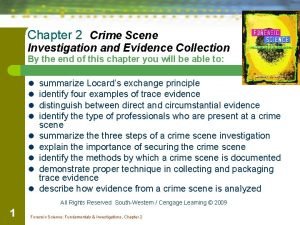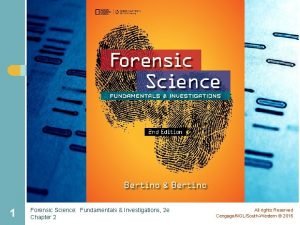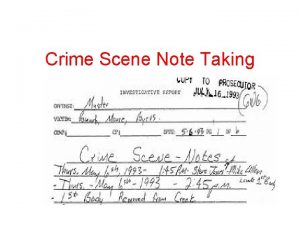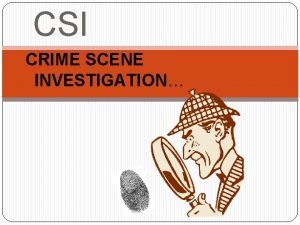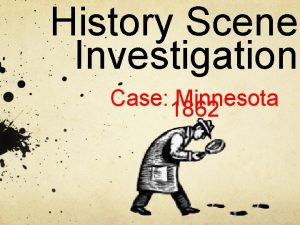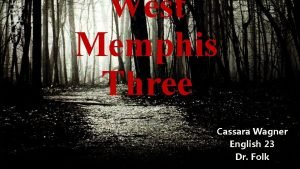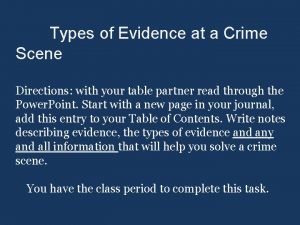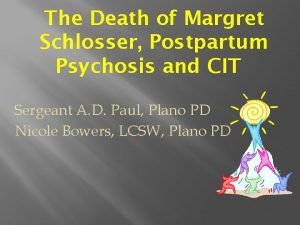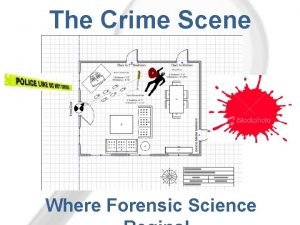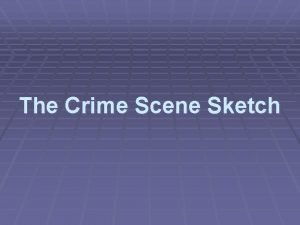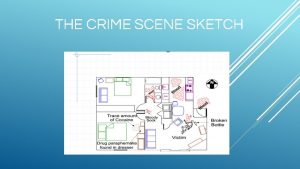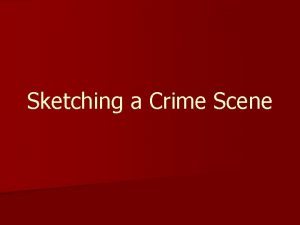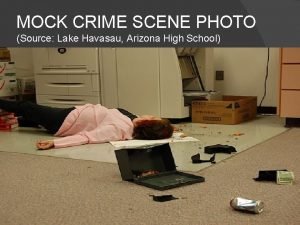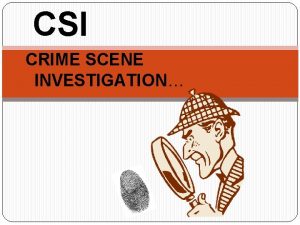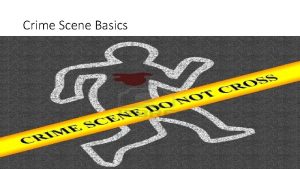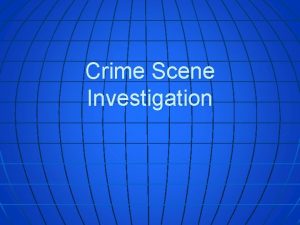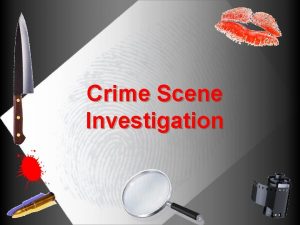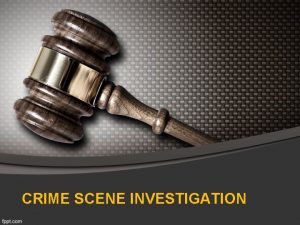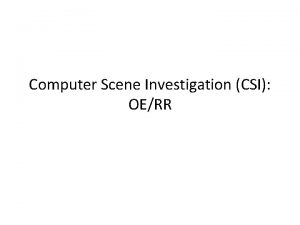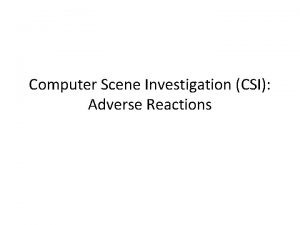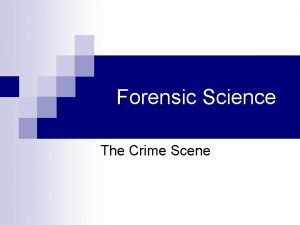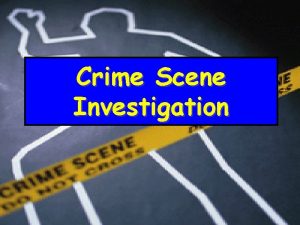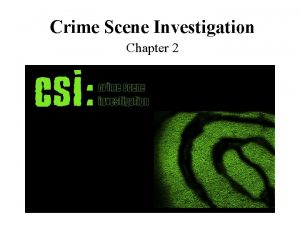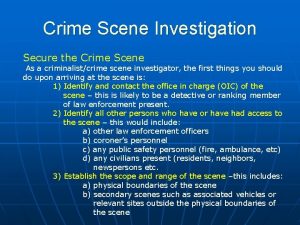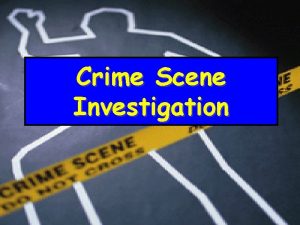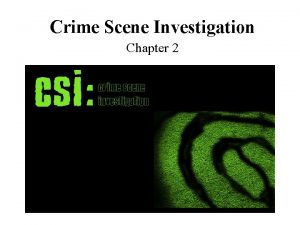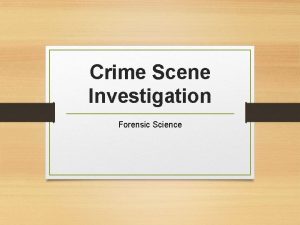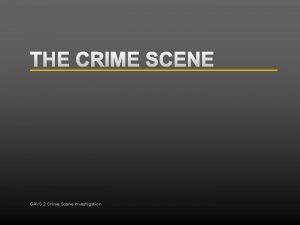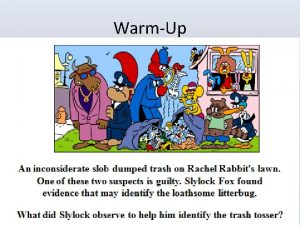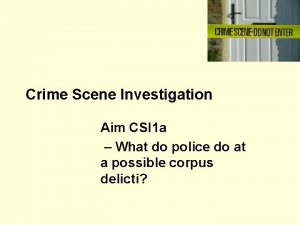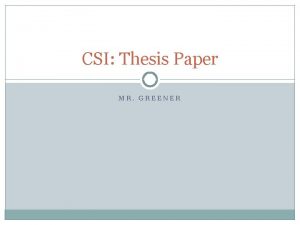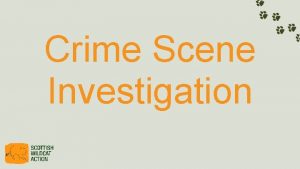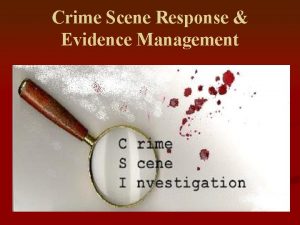CSI CRIME SCENE INVESTIGATION Most people are familiar





























- Slides: 29

CSI CRIME SCENE INVESTIGATION…

Most people are familiar with forensics as it is portrayed on television in such things as CSI, NCIS and other detective programs.




NCIS

WHAT IS FORENSIC PATHOLOGY?

Forensic Pathology: Forensic pathology is a branch of pathology concerned with using medical principles and scientific procedures to analyze the physical evidence associated with criminal investigations. Healthcare professionals in forensics determine the cause of death, injury or disease. The autopsy is performed by the pathologist at the request of a coroner or medical examiner. Forensic pathologists are also frequently asked to confirm the identity of a cadaver.

Forensic Pathologist The responsibilities of a forensic pathologist include: studying the causes, nature and effects of disease and injury by conducting laboratory experiments. They study tissue, fluids and cells of the human body. Forensic pathologists apply medical facts to legal questions. They are medical detectives that present evidence that helps determine the cause of death.

Other tasks … Testify in court about investigative and analytical methods and findings. Keep records and prepare reports detailing findings, investigative methods and laboratory techniques. Interpret laboratory findings. Operate and maintain laboratory equipment. Collect evidence from crime scenes, storing it in conditions that preserve its integrity. Identify drugs and poisons found in body fluids, in foods and at crime scenes.

Other tasks … Reconstruct crime scenes to determine relationships among pieces of evidence. Examine DNA samples to determine if they match other samples. Analyze handwritten and machine-produced written evidence to determine authorship, age or source.

Needed skills… Science, chemistry, math Speaking Quality Control analysis Reading Comprehension Critical Thinking Active Listening Writing

Forensic Pathologists must be very observant about even the smallest details. How observant are you? How many animals can you see in this scene?

Are you ready to try more of your observational skills? Directions: You will have 30 seconds to view the next screen. Try to memorize all 20 items that you see. You are NOT allowed to write anything down. You CANNOT talk to anyone else.

Items to remember…

What do you remember? You have 2 minutes to list as many of the items as you can!

How did you do? All 20: Awesome! 15 -19: Great 10 -14: Pretty swell 5 -9: Could be better 4 or less: Wake up

Whether you are a forensic pathologist or an eyewitness, your ability to observe and recall details can be critical. According to the Innocence Project (2008) “Eyewitness misidentification is the single greatest cause of wrongful convictions nationwide, playing a role in more than 75% of convictions overturned through DNA testing. ”

Research shows that the human mind is not like a tape recorder; we neither record events exactly as we see them, nor recall them like a tape that has been rewound. Instead, witness memory is like any other evidence at a crime scene; it must be preserved carefully and retrieved methodically, or it can be contaminated.

If you were looking at crime scene photos, could you tell that the evidence had been tampered with? Can you spot 5 differences in the two pictures?

Let’s practice with another spot the difference challenge… How many differences can you spot?

Crime scene challenge Now that your eyes and brain are warmed up, let’s test your observation skill a little more. You will have 2 minutes to study the photograph of a crime scene on the next slide. Try to pay attention to details as you will be asked 10 questions about the crime scene! You are not allowed to write anything down until after the time is up…. Ready? ?


Answer each question below. 1. What color coffee mug was in the picture? Blue Red Yellow Green 2. When was the deadline? Yesterday Today Tomorrow June 3 rd 3. What time was on the clock on the wall? 10: 40 11: 05 1: 55 2: 15 4. How many sticky notes were on the whiteboard? Four Six Eight Ten 5. Which of the following was NOT in the picture? Stapler Trash Can Printer 6. What was the name on the plaque on the desk? Bill Brian Carl Dave 7. What color was the victim's shirt? Black Blue Red Plaid 8. How many plants were in the picture? None One Two Three 9. What was the color of the marker in the desk drawer? Red Blue Green 10. Where was the book in the picture? On a box In the trash can Under the body Source: http: //forensics. rice. edu/html/picture_begin. html

What do you think? Are you still interested in Forensic Pathology?

The steps to become a Forensic Pathologist in the USA are: 1. Pre-medical school: 3 -4 years 2. Medical School: 4 years 3. Pathology Residency: 4 years (if anatomical path residency) or 5 years (if combined anatomical + clinical pathology) 4. Fellowship: 1 -2 years

Money---Money Forensic pathologists’ salaries average $80, 000 to $200, 000+ per year depending on experience, job setting and responsibilities.

If you think this is a career for you…. . set your goals and WORK towards it!!!!

And perhaps the beginning of a new career goal!
 While the csi team is searching the crime scene, _____.
While the csi team is searching the crime scene, _____. Mikael ferm
Mikael ferm Seven s of crime scene
Seven s of crime scene Intermediate crime scene investigation tcole
Intermediate crime scene investigation tcole Intermediate crime scene search #2106
Intermediate crime scene search #2106 Oconnors bakery
Oconnors bakery Crime scene investigation vocabulary
Crime scene investigation vocabulary 2106 crime scene investigation
2106 crime scene investigation Corpus delicti
Corpus delicti Crime scene investigation background
Crime scene investigation background What are the 5 steps in crime scene investigation
What are the 5 steps in crime scene investigation Locard exchange principle
Locard exchange principle Locard's principle of exchange definition
Locard's principle of exchange definition Intermediate crime scene investigation texas
Intermediate crime scene investigation texas Note taking crime scene investigation
Note taking crime scene investigation 7 s's of crime scene investigation
7 s's of crime scene investigation Most people are familiar with
Most people are familiar with Csi computer crime and security survey
Csi computer crime and security survey Historical scene investigation
Historical scene investigation History scene investigation
History scene investigation Christopher byers autopsy photos
Christopher byers autopsy photos Types of crime scene
Types of crime scene Dena schlosser margaret schlosser
Dena schlosser margaret schlosser Finished sketch
Finished sketch Cross projection sketch
Cross projection sketch Crime scene sketches
Crime scene sketches Graphsketch
Graphsketch Rough sketch crime scene
Rough sketch crime scene Crime scene basics crossword answer key
Crime scene basics crossword answer key Crime scene factoring and quadratic functions answer key
Crime scene factoring and quadratic functions answer key
